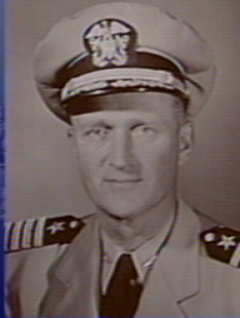Captain Robert F. Farrington, USN
CAPT Robert Faulkner Farrington graduated from the U.S. Naval Academy in 1937, and underwent flight training at Pensacola Naval Air Station, where he earned his wings as a naval aviator. He served aboard the battleship USS Mississippi (BB-41), and commanded a torpedo bomber squadron aboard the carrier USS Lexington (CV-2) when World War II broke out.
Highly decorated during World War II, his awards include two Navy Crosses, the Navy's highest award for valor with the exception of the Medal of Honor, and two Distinguished Flying Crosses.
He was awarded the Bronze Star during the Korean War.
CAPT Farrington won both his Navy Crosses for his actions during the Battle of the Coral Sea in 1942, while flying from the USS Lexington (CV-2). It was during that battle that the Imperial Japanese Navy suffered its first strategic defeat in its history. American pilots sank one Japanese carrier and badly damaged another.
The citation for CAPT Farrington's first Navy Cross states that during the battle, "he pressed home a vigorous and determined torpedo attack in the face of heavy antiaircraft fire and made a direct torpedo hit on an enemy ship."
His second Navy Cross cited his acts of "extraordinary heroism," and states that "by complete disregard for his own personal safety he was able to score a hit on the enemy carrier, thereby contributing to the destruction of that vessel."
During the Battle of the Coral Sea, the USS Lexington suffered numerous bomb hits from Japanese planes that set off internal explosions, which caused the ship to be abandoned and sunk by American destroyers. The USS Yorktown, which was badly damaged in the fight, was quickly patched at Pearl Harbor, then sailed to the Battle of Midway, where it went down fighting.
CAPT Farrington went on to earn his Distinguished Flying Crosses during the fighting for New Britain and Bougainville in November, 1943. He also helped train Army Air Forces pilots for Pacific operations and served in Washington before the end of the war. He served as a carrier air group commander during the Korean War.
His later assignments included command of the seaplane tender USS Salisbury Sound (AV-13) from 10 Sep 1959 - 27 Jul 1960, the aircraft carrier USS Ticonderoga (CVA-14) from 24 August 1960 - 25 August 1961, and a tour of duty as chief of staff of a carrier division. He also graduated from the National War College, and was on the staff of the Joint Chiefs of Staff when he retired in 1967.
After retiring from the Navy, he worked for the Boeing Company as an engineer on the Apollo Space Program. In 1973, he joined George G. Sharp Inc., a naval architectural firm, where he worked as a senior design engineer until the time of his death.
A native of Yonkers, N.Y., CAPT Farrington received a master's degree in international affairs from George Washington University.
He was a member of the American Society of Naval Engineers, the Society of Naval Architects and Marine Engineers, and the Tantallon Golf and Country Club. He was active in the Boy Scouts of America and was a 1981 recipient of the BSA National Council's Silver Beaver award.
CAPT Farrington died of cancer on May 3, 1989, at Bethesda Naval Hospital, at the age of 74. He lived in Fort Washington.
His first marriage to Virginia Savage ended in divorce. Survivors include his wife, Helen Farrington of Fort Washington; two sons by his first marriage, Robert F. Farrington Jr. of Newberg, Ore., and Dr. Richard Farrington of Oakland, Calif.; a brother, David Farrington of Tampa, Fla., and four grandchildren.

